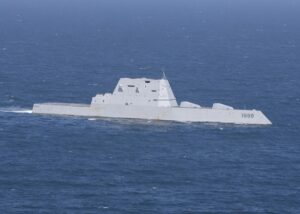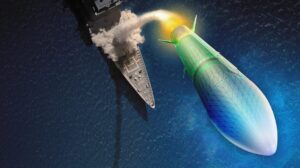The Navy awarded HII [HII] a $10.5 million contract on Jan. 6 to plan the modernization work that will install the Conventional Prompt Strike (CPS) hypersonic weapons on the Zumwalt-class destroyers.
The work will occur at HII’s Ingalls Shipbuilding facility in Pascagoula, Miss., and is expected to be finished by December 2023.

General Dynamics’ Bath Iron Works (BIW) [GD] built the three Zumwalt-class destroyers, but HII built the ships while HII built the deckhouses.
The Navy plans to replace the unused gun system on the USS Zumwalt (DDG-1000) with four 87-inch large diameter missile tubes and CPS weapons during an 18-month availability running from fiscal years 2024 to 2025. The service plans to conduct two to three test shots before the end of 2025.
In November, Vice Adm. Johnny Wolfe, the Navy’s director for Strategic Systems Programs, said the primary challenge of integrating hypersonic weapons onto the Zumwalt is the three-year timeline (Defense Daily, Nov. 8).
Notably, the contract was not competitively procured in accordance with U.S. Code regulations with only one responsible source.
A redacted Navy document, justifying the approval for a non-competitive award in this case, argued that given the strict timelines BIW and HII’s “thorough knowledge of these complex systems, significant planning expertise and production workforces, as the only and original ship designers and shipbuilders for the DDG-1000 class, are critical to providing the required level of production, engineering, and maintenance support necessary to successfully complete” the work.
The document was signed off in November by Frederick Stefany, principal civilian deputy to assistant secretary of the Navy for research, development and acquisition and performing the duties of assistant secretary of the Navy for research, development and acquisition.
“Accordingly, only BIW and HII, as the Navy’s destroyer shipbuilders, have the manpower with experience designing, engineering, planning, and constructing DDG-1000 class ships with weapon systems capabilities” such as the large missile vertical launch system (LMVLS).
The document also noted the USS Michael Monsoor (DDG-1001) is planned to have its upgrade work last from FY ‘26 to FY ‘28.
The Navy said installing the new system is a “major structural change, comprising nearly an entire new construction ultra-module.”
This upgrade process will remove the only Advanced Gun System mounts and replace them with the CPS-capable LMVLS.
The document argued repair yards do not have the relevant experience and resources with construction and assembly of such ultra-module stacks to install the hypersonic missile system.
“Specifically, repair yards do not possess the required design, engineering, and planning capability to execute the Navy’s significant new construction type requirement” during planning and execution of the work.

“Use of an alternative source, other than BIW or HII, would result in significant ship and program schedule delays, resulting in unacceptable adverse impacts” of operational requirements to have the system ready on the DDG-1000 by FY ‘26 and DDG-1001 by FY ‘28, the Navy continued.
The Navy estimated it would take a further 22 months to award a competitive contract for this upgrade, with an award in the third quarter of FY ‘24, significantly delaying the work by up to two years “based on historical timelines of performing full and open competition for similar efforts.”
The service also argued executing the hypersonic weapon upgrades for DDG-1000 and 1001 at separate shipyards would add “significant execution risk” because it would need “considerable additional time and resources” to gain familiarity with the class and CPS work package to efficiently install and integrate the LMVLS.
The Navy said while it issued a sources sought notice the responses from other potential contractors “did not demonstrate new construction experience.”
“Ingalls is honored to have been selected to deliver this new capability with our Navy and industry partners. Our shipbuilders stand ready to do what is necessary to enable our fleet in the protection of peace around the world,” Ingalls Shipbuilding President Kari Wilkinson said in a statement.